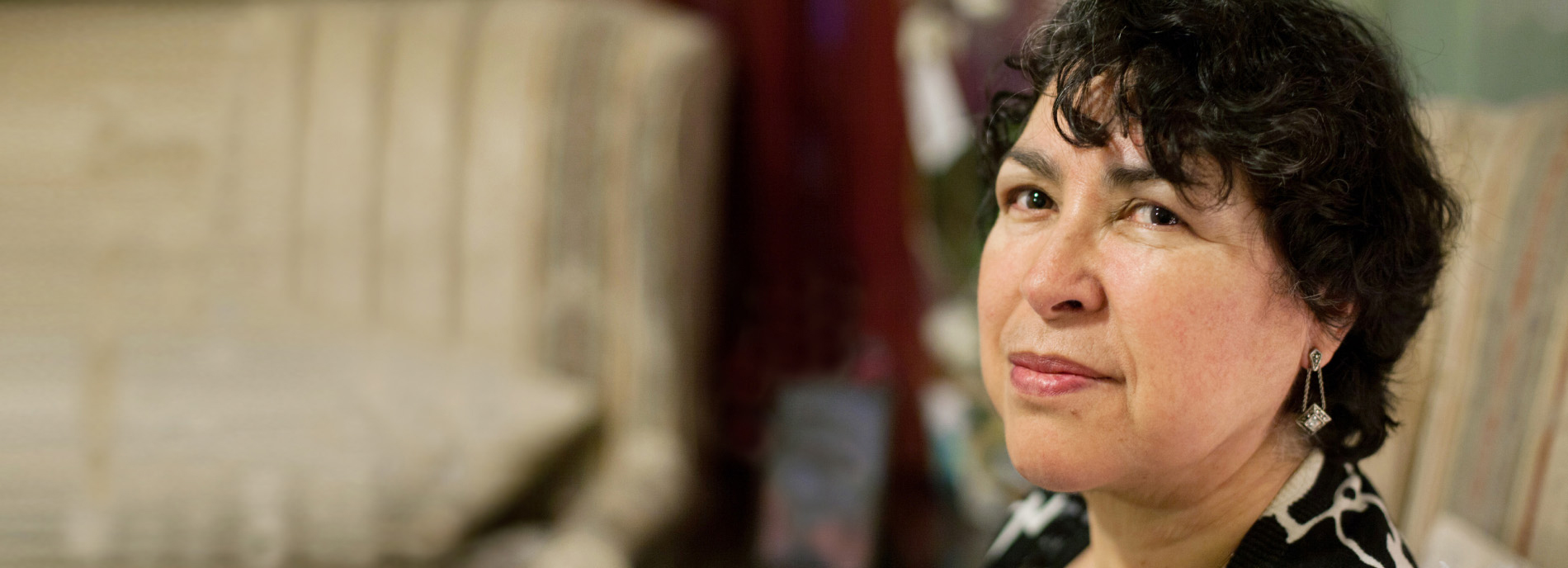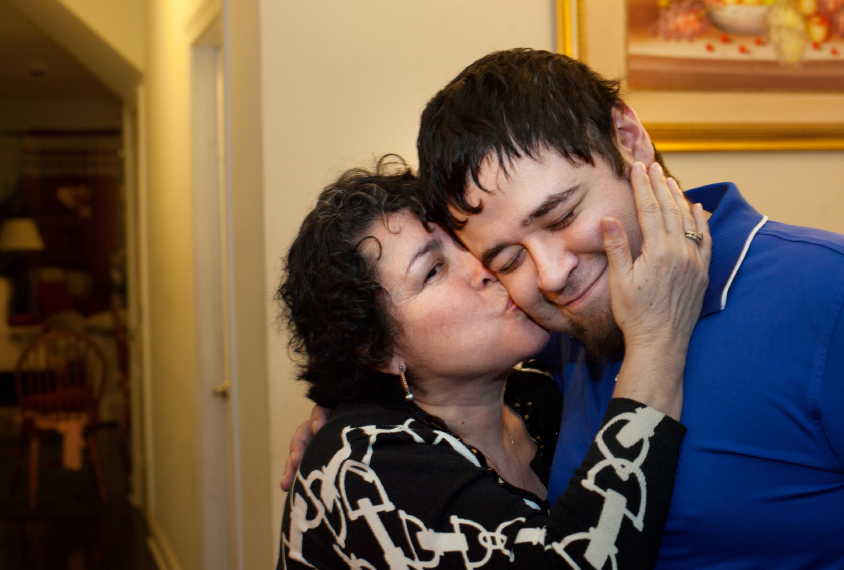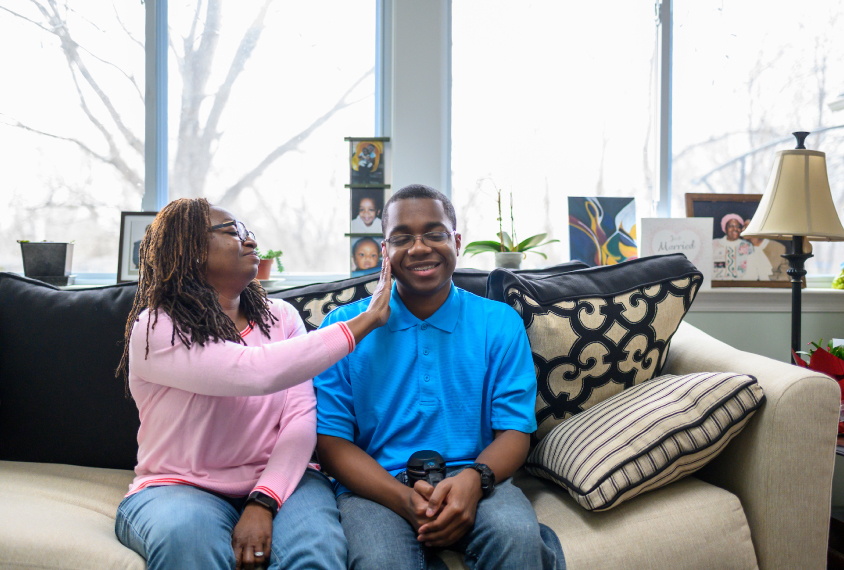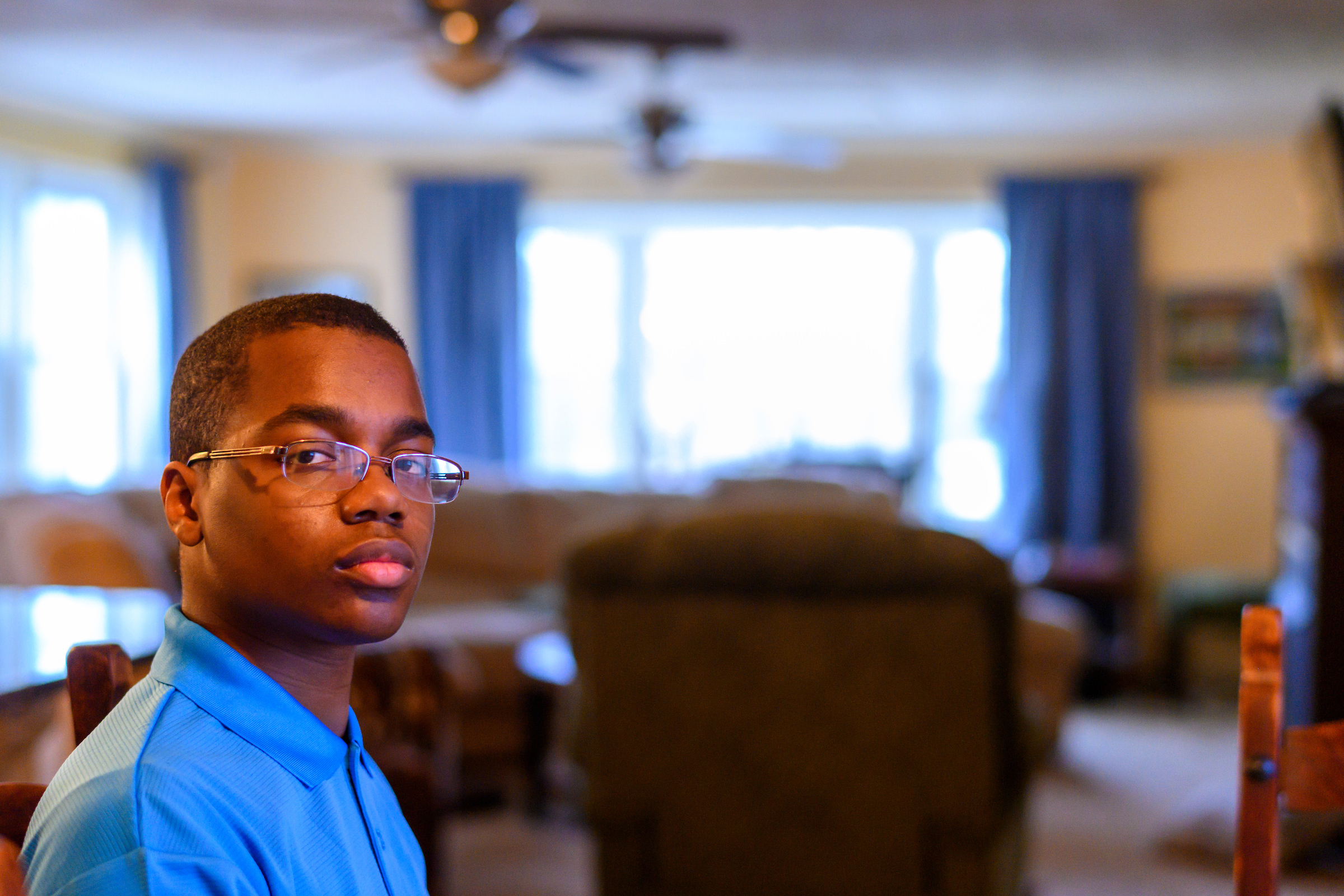
How to help low-income children with autism
Autistic children from low-income families are undercounted and underserved, a gap community leaders are working to bridge.
A
light snow is falling on this sleepy Saturday morning in November in Chicago. Despite the weather, a steady stream of families pours into the lobby of a nondescript brick building: middle-aged parents with gadget-toting teenagers, young couples with rambunctious toddlers. Some have traveled an hour or more to come here, the Developmental Disabilities Family Clinic at the University of Illinois at Chicago. Their draw is the monthly meeting of Grupo Salto, a nonprofit organization that aids Spanish-speaking, low-income families with autistic children.Most of the attendees have been here before. They sign in, exchange a few warm words with acquaintances and disperse. Parents drop off small children for an art class or supervised play and then head to the auditorium for an educational session. (Today a state representative is giving an overview in Spanish of public services that help individuals with disabilities find work.) A gaggle of young adults on the spectrum peels off to another room for “Tú y Yo” (You and I), where they advise each other on everything from college applications to romantic relationships.
Flitting amid the incoming families is Matie Ovalle, who co-founded Grupo Salto in 2003 with her husband and the university clinic staff. Though she’s nearing 60 and complains of aging knees, Ovalle moves through the crowd with the grace of a dancer. She hugs a longtime member whose headscarf gives away her challenges with chemotherapy — “Mami, we’ve missed you!” — then pivots to offer reassurances and parking directions to a 20-something woman whose son was diagnosed with autism a month earlier. Ovalle, who is also a policy analyst at the clinic, has twin sons, now 28, who are both on the spectrum.

As the crowd thins, two women look uncertainly around the lobby. They have brought their teenage nephew with them to be screened for autism. A volunteer takes them to meet Ann T. Cutler, who is a developmental pediatrician at the university, and her bilingual graduate student, who deliver the Social Communication Questionnaire. A few minutes into conversation with the boy, Cutler observes multiple signs of autism, including a lack of affect and diminished eye contact. The results of the 45-minute screening support her observations, and she refers the boy for a formal evaluation, which is scheduled for February. At 13, he is nearly a decade older than when most children are diagnosed. At Grupo Salto, he is hardly an exception.
Most of the families in Grupo Salto qualify for Medicaid — a government program that provides healthcare coverage to tens of millions of low-income people in the United States. Most of the caregivers also speak only a little English and have no more than a high-school education. Although this organization caters specifically to Spanish-speaking families, children of all ethnic backgrounds from low-income communities are, on average, diagnosed with autism later than children from wealthier communities — if they are diagnosed at all.
That means the needs of an untold number of children aren’t being met. It also has serious ramifications for research, because it can skew estimates of autism, says Maureen Durkin, an epidemiologist at the University of Wisconsin-Madison: “It means that the prevalence of autism is probably even higher than we’re measuring.”
Aware of this urgent problem, scientists and community groups are striving to solve it. They are, for example, providing autism training to pediatricians who serve low-income communities; they are offering marginalized families individual support; and they are connecting families with others who have had similar experiences.
The need is enormous. Grupo Salto offers valuable support for more than 500 Chicago-area families. “Many parents have never heard of autism before their child is diagnosed,” Ovalle says. “We help them understand what autism is, what resources are available and that they have a community that understands what they’re going through.”
Money divide:
N
umerous studies, starting with Leo Kanner’s seminal 1943 paper in Nervous Child, have suggested — mistakenly, researchers now suspect — that autism occurs more often in children from affluent, highly educated, white families. Kanner described a “very interesting common denominator” among his young patients, commenting that they all came from prominent, “highly intelligent families”:Four fathers are psychiatrists, one is a brilliant lawyer, one a chemist and law school graduate employed in the government Patent Office, one a plant pathologist, one a professor of forestry, one an advertising copy writer who has a degree in law and has studied in three universities, one is a mining engineer, and one a successful business man. Nine of the eleven mothers are college graduates. … All but three of the families are represented either in “Who’s Who in America” or in “American Men of Science,” or in both.
The first studies of autism prevalence a quarter century later estimated that the condition affected only about 3 children in every 10,000, again mostly in families with high socioeconomic status.
Since then, autism prevalence has risen dramatically to 1 in 59 children, in part thanks to increased awareness and policies for routine screening. And yet the socioeconomic disparity Kanner noted has persisted. One 2015 report, for example, found steady increases in autism prevalence among low-income children receiving some form of government aid between 2000 and 2012. But based on estimates of the condition in the general population, the prevalence was still significantly lower than it should have been: Less than half the expected number of low-income children had an autism diagnosis.
Durkin and her colleagues saw a similar pattern when they analyzed health and education records of more than 1 million children at age 8 from 11 states. From 2002 to 2010, they found, autism prevalence increased overall from 6.2 to 11.9 per 1,000 children across all socioeconomic levels. But the gap between low-, middle- and high-income children did not change. The highest prevalence of autism was still among the highest socioeconomic groups.
Several factors strongly suggest that the discrepancy is not real. For instance, of the more than 13,000 children the analysis identified as meeting the criteria for autism, 16.6 percent did not have an official diagnosis — and those children were more likely to live in a low-income area than children with a diagnosis. This socioeconomic gap is less stark in European countries that offer government health services.
The predominantly privatized healthcare system in the U.S. can require a half-dozen doctor appointments to obtain a referral for a diagnostic evaluation, and it can result in waiting lists of a year or longer in some parts of the country. “It’s so complicated to get an autism diagnosis and treatment [in the U.S.],” says Katharine Zuckerman, a pediatrician at Oregon Health and Science University in Portland. “When we have this process that’s really convoluted and complicated, it’s always the families with the least privilege who don’t make it through.”
Those delays cost low-income families disproportionately. To begin with, their autistic children may miss out on early interventions. Studies show that autistic children who receive behavioral interventions at around age 3 develop better language vocabulary than those who start at age 4, never mind even later. But also, an earlier diagnosis can be key for obtaining affordable treatment. Wisconsin, for instance, provides free services for any child with autism — so long as they receive a diagnosis by age 8. For low-income families, hitting that deadline is far from guaranteed.
”“Because we had resources, John got the services he needed. What about families that don’t have the means?” Wendy Shaia
Built-in bias:
R
acial or ethnic bias and the effects of poverty interact in complicated ways to block some children from getting timely autism diagnoses and services.It’s a puzzle that Wendy Shaia is all too familiar with. Shaia, executive director of the Social Work Community Outreach Service at the University of Maryland, Baltimore, began seeking services when her son John was about 2 years old. John was slow to talk and did not respond to his name or make eye contact, and Shaia was convinced he was on the spectrum. But her pediatrician and other healthcare providers proposed a litany of other conditions, including auditory processing disorder, obsessive-compulsive disorder, generalized anxiety disorder and attention deficit hyperactivity disorder.
“I’m thinking, I’ve got my masters in social work; I’m working on my doctorate in education. I’m middle class and educated, so why won’t you consider that my child is on the spectrum?” she says. “We’re a black family — that matters. There is very much a sense that autism is a white disorder, a white condition.”
Research shows that black children who eventually receive an autism diagnosis are more likely to be initially misdiagnosed than white children are. John was not diagnosed with autism until he was 10 — at which point Shaia, who had private insurance and did not need referrals from a primary-care physician, had already arranged for speech and occupational therapy and an individualized education program at school. But the experience got her thinking. “Because we had resources, John got the services he needed,” she says. “What about families that don’t have the means?”

She and her colleagues explored that question last October through the experiences of 22 female caregivers in Baltimore — 20 of whom are black, one who is white and one Hispanic. Of the 22 women, 8, or 36 percent, reported that healthcare providers disregarded their early concerns about their children’s developmental delays. How the women responded to this disregard diverged along education and socioeconomic lines. “Those who ignored the pushback from their providers and went ahead and sought a diagnosis, those parents were more highly educated and had a higher income,” says Sarah Dababnah, assistant professor at the University of Maryland, Baltimore. Their children were diagnosed with autism by age 5 on average, about a third of a year earlier than those of lower socioeconomic status.
Although the sample size in Dababnah’s qualitative study was small, the finding could help explain why, in Durkin’s analysis, children at the lower end of the socioeconomic spectrum consistently seem to show a low prevalence of autism. “If you’re black and low-income, you have a much less chance of being identified as having autism,” Durkin says. By contrast, wealthier black families show no differences from wealthier white families in autism prevalence.
Compared with low-income black children, low-income Hispanic children — such as those who seek help from Grupo Salto — are even less likely to receive autism diagnoses or services. At least part of the difference is due to language barriers. Sometimes, “a child will be diagnosed and then [the parents] are not given information and forms they can use,” says Sandy Magaña, professor of autism and neurodevelopmental disabilities at the University of Texas at Austin. “Three or four years later, they still don’t know what autism is in their child.”
In 2009, Magaña reported that middle-class white families in Wisconsin were more likely to obtain state-funded therapy for their autistic children than low-income Latino families. In that analysis of 49 counties, she found that white families made up 86.2 percent of the population and Latinos 4.3 percent. Yet among the children receiving autism services, 88.6 percent were white, and only 3.2 percent were Latino.
Having poor access to healthcare, or none at all, only discourages these families even more. In numerous surveys, black and Latino caregivers report experiencing racial or ethnic bias from healthcare providers. “When they don’t feel they can trust their provider,” Dababnah says, “that’s huge.”
Remote access:
G
eography cuts some low-income children off from autism diagnoses and quality care. Autism appears to be less prevalent in rural communities than in urban ones, but distance from clinics can delay diagnosis. It can also increase the costs of seeking services, often putting them out of reach for low-income families.In Montana, the third most sparsely populated state after Alaska and Wyoming, access is a big challenge, says Jake Henderson, service director for AWARE, a statewide nonprofit that provides services to people with mental illness and developmental disabilities. “If you’re living out in Eastern Montana, you may have to travel two to three hours to get to a clinician, to go to a psychiatry evaluation,” he says. “Even then, there’s a really limited number of providers with autism expertise in the state.”
Like Shaia in Baltimore, Teri Noon, a resident of Belgrade, Montana, became concerned about her son’s health when he was about 2. Joseph stopped speaking and interacting, so Noon took him to her pediatrician — one of the only ones in town.
Noon followed the doctor’s advice to wait and see. When Joseph did not improve, the pediatrician diagnosed a hearing problem and put tubes in his ears. It didn’t help. So out came Joseph’s tonsils. Then his adenoids. Joseph still did not speak — and he started rocking violently, screaming and sleeping poorly. Growing increasingly desperate, Noon drove several hours to Helena, Montana, to see a specialist. “The neurologist told us that the part of Joseph’s brain that deals with speech and comprehension didn’t work and he would never speak with anything other than utterances in his life,” Noon says. She paid $1,000 out of pocket for that visit and the other medical bills; her family couldn’t afford private insurance, but they earned just enough to not qualify for Medicaid.
When Joseph was 4, Noon took him for a physical examination needed to enroll him in Head Start, a federally funded early-childhood education program for low-income families. The clinic staff did not believe that Joseph couldn’t speak, she says. When a nurse went to draw blood from his finger, he repeatedly threw his head back into Noon’s chest and thrashed. “The nurse said, ‘If you bite me, that’s the last thing you’re ever going to do,’” Noon recalls. “I left there bawling.”
An hour later, however, someone from the clinic called to set up an appointment for Joseph with a case manager from AWARE. Five minutes into that meeting, the following week, the case manager told Noon she thought Joseph has autism.
“Okay,” Noon remembers saying. “What’s that?”
Through AWARE, Joseph, now 17, saw a psychiatrist and other therapists, and he was assigned behavioral aides and a case manager who made monthly home visits and helped Noon navigate the medical system. Things were still tight financially. Noon was afraid that if she quit her job to gain Medicaid coverage, they would not be able to afford their house payments or grocery bills. So the family paid up to $1,000 each month for Joseph’s behavioral medications and therapy. After six years on a waiting list, at age 10, Joseph obtained a waiver from the state to cover his care.
A series of cuts to Montana’s budget during 2017 and 2018 forced AWARE to make cuts of its own, Joseph lost access to many of the organization’s services, along with his longtime case manager, aides and psychiatrist. He has since had four case managers from the state, the most recent of whom has spent no more than an hour with him, Noon says. The case manager and Noon exchange emails and the occasional phone call, but Noon says she feels like she is once again flailing, and struggling with the paperwork required to get the funds for his services.
”“When we have this process that's really complicated, it's always the families with the least privilege who don't make it through.” Katharine Zuckerman
Making connections:
A
new wave of initiatives aims to ensure that caregivers like Noon will not have to figure it out on their own.Magaña is exploring the use of video modules or e-learning to reach remote communities in Texas. Durkin, meanwhile, is working to make the vast amounts of information about autism services on the University of Wisconsin website more user-friendly and more accessible to a broad audience. Her team is also looking at providing training and support to clinicians who may see people with autism in rural and underserved urban communities.
This sort of training for pediatricians could go a long way toward helping them help low-income and minority families, Zuckerman says. “We found that a lot of pediatricians felt really uncomfortable identifying the early signs of autism in general, but particularly for families who are from a different culture,” she says. In May, Zuckerman and her colleagues reported on the results of a 12-month project in which they trained 42 clinicians serving Latino communities to screen for autism and refer at-risk children for further evaluation. They also taught the doctors how to talk with caregivers about autism and available services. After the training, providers conducted autism screenings at 89 percent of the 18- and 24-month well visits they conducted, up from 58 percent.
“In early childhood, especially if you are a low income family or a racial ethnic minority family, your primary-care provider might be the only person with any developmental expertise you encounter,” Zuckerman says. “How they act and what they do is really important in terms of what services families will ultimately access.”
Some researchers are investigating one-on-one interventions with families. In 2011, Magaña spearheaded a pilot study with 19 Latino families in Wisconsin, pairing up Spanish-speaking parents of newly diagnosed children with volunteer parents whose children had been diagnosed years before. Her team gave the volunteers, called ‘promotoras,’ a solid base of information about autism and available services. Then they sent the promotoras out on weekly home visits for 14 weeks. “It addresses a lot of cultural issues because they’re from their own cultural communities, speak the same language and can relate to them as a peer,” she says. Families that received the intervention increased their knowledge of autism, empowerment in seeking services and confidence and frequency in using evidenced-based strategies, the researchers found. What’s more, their children’s communication improved.
Magaña is analyzing the results from a four-year randomized trial of the same program with 100 families in both Chicago, where members of Grupo Salto took on the role of promotora, and Los Angeles.
In Baltimore, Shaia and Dababnah are also testing a parent-to-parent approach. They trained three mothers who began working with 20 black families late last year. With input from an advisory panel — comprising parents of autistic children, an individual on the spectrum, providers and educators — they tweaked Magaña’s manual, tailoring the language and images to fit the experiences of the local black community. They are enrolling families with newly diagnosed children, as well as those who have just received a screening. “Right now, we’re in the feasibility stage,” Dababnah says. With positive results, they plan to scale up.

Another adaptation is being deployed in southern California. The state committed $11 million toward such initiatives in 2016, after data showed that minority families visiting its 21 regional centers for people with disabilities were receiving fewer services than white families. Each center is exploring targeted strategies to lessen the disparity. Psychologist Lauren Brookman-Frazee partnered with San Diego’s regional center to implement parent-led interventions for 40 children. Unlike most interventions, which are developed for younger children, this one focuses on children aged 11 to 16, because, she says, “they’re the ones who have really been overlooked, who are missing out on services.” The pilot project, now nearing the end of its second year, aims to examine whether the families access more services at the end of the intervention.
In New Haven, Connecticut, Boston and Philadelphia, paid ‘family navigators,’ rather than volunteers, are delivering interventions as part of a five-year trial. More than 80 percent of the 340 families receive public insurance. Like the promotoras, some of the navigators are culturally matched to the families they meet. They track the families from an initial referral — when the child is aged 15 to 27 months — to 100 days after diagnosis, ensuring that the child is treated. Others serve as more traditional case managers and advise caregivers by phone. “One of the main goals is not only getting children connected to services, but reducing the amount of time to get the diagnosis,” says project coordinator Andrea Chu.
The preliminary results look promising, Chu says, although it’s too early to know which of these interventions will ultimately pan out. There’s also the question of finding the funding to expand them. “It’s expensive,” Zuckerman says, “but failing to diagnose autism is expensive, too.”
The best of these efforts might seed communities like Grupo Salto. As the November meeting comes to a close, Ovalle’s husband, José, opens up the floor in the auditorium to questions. Attendees ask for advice on a tricky situation at school. They wonder whether their children will ever drive. One father queries the crowd to find out if older children on the spectrum have romantic relationships. Parents share their fears about what will happen to their children when they become too old to care for them.
José Ovalle talks about the importance of keeping all of their children tied to their community. Securing support for a child with autism can be difficult for any parent. For the low-income caregivers he is addressing, whose children are more likely to be overlooked and discounted by the healthcare system, he knows it can be extra challenging. “Autism is forever,” he says. “It’s very important for us to work toward looking after them as much as we can.”
Syndication
This article was republished in The Independent.
Recommended reading

Developmental delay patterns differ with diagnosis; and more

Split gene therapy delivers promise in mice modeling Dravet syndrome

Changes in autism scores across childhood differ between girls and boys
Explore more from The Transmitter

Smell studies often use unnaturally high odor concentrations, analysis reveals

‘Natural Neuroscience: Toward a Systems Neuroscience of Natural Behaviors,’ an excerpt
